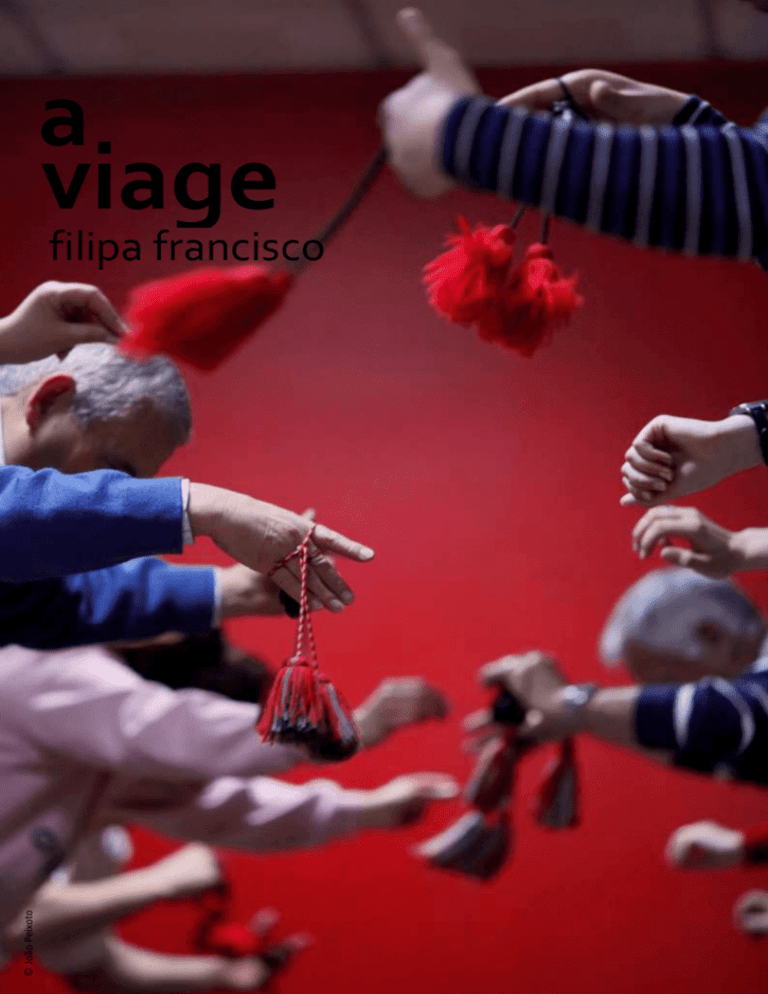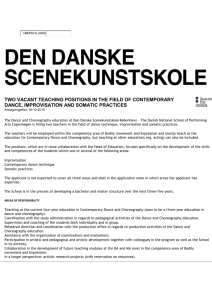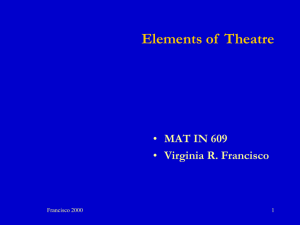AVIAGEM_InfoPress_EN
advertisement

© João Peixoto a viage filipa francisco m A VIAGEM [The Journey] is a new project developed by choreographer and performer Filipa Francisco. In it, she works with folk dance groups in various phases: a preparation phase in which folk dancers are introduced to contemporary dance, a period of artistic residency and, finally, presentation of the finished piece. The folk dancers are co-creators of the performance, bringing their specific imagery to the vocabularies of contemporary and traditional dance. A VIAGEM also incorporates professional dancers, building bridges between ‘worlds’ that do not often come into contact. Duration 50 mins (aprox.) CREDITS Concept and artistic direction Filipa Francisco Assistant to the artistic director Pietro Romani Performers David Marques, Antónia Buresi, Grupo Folclórico da Corredoura Costumes Ainhoa Vidal Music António Pedro, Grupo Folclórico da Corredoura Lighting design and technical direction Mafalda Oliveira Executive producer Filipa Achega Co-produced by Mundo em Reboliço, Festival Materiais Diversos, Guimarães 2012 – European Capital of Culture, Teatro Virgínia (Torres Novas) Acknowledgements alkantara, Rancho Folclórico “Os Camponeses” de Riachos, Rancho Folclórico da Gouxaria, Rancho Folclórico de Torres Novas Financed by Presidência do Conselho de Ministros – Secretaria de Estado da Cultura/Direcção-Geral das Artes A NOTE ABOUT THE ARTIST Filipa Francisco’s artistic creations are intimately connected to her own reflections and research on the social and political functions of art. Filipa is dedicated to creating encounters with the audience, even – especially – when this means dislocating her artistic work to spaces where the possibility of that encounter are greater. In a letter exchanged with Basque choreographer Idoia Zabaleta (co-creator of the piece “Dueto”), Filipa rearticulates her concern for the political nature of art and reaffirms her interest in working in and with communities: “If I were to construct a space for a body to move, what kind of space would it be? To construct a space or use those that already exist, planting them like mushrooms or viruses in abandoned spaces, in peripheral neighbourhoods like Cova da Moura (in the Lisbon periphery) or next to big theatres – this seems to me to be an interventionist and political act.” (19 September 2005) -1- This spirit has led Filipa to participate in artistic projects with groups of prison inmates (Projecto Re-existir), creating with them the widely-toured piece “Nu Meio”. She has also worked with teenagers as part of social reintegration programmes in educational centres. She coordinated a long-term contemporary dance programme in the ‘critical’ neighbourhood Cova da Moura, from which came the piece “Íman” (Magnet), distinguished in the national newspaper Público as “the best dance piece of 2008.” In Ramallah, Palestine, she led a workshop with Carlos Pez for the El-Founoun Traditional and Contemporary Dance Company. The desire to work with traditional dance groups springs from this experience in Ramallah: “Travelling with the group in Palestine, watching their performances in small villages, I realised how powerful traditional dance is. It addresses very topical issues like identity, gender and liberty. The act of dancing, for these young people, was actually a cry of freedom, a way of liberating themselves from the difficult memories of war.” As an artist Filipa is interested in creating territories of questioning, creating access to art in improbable places, allowing her work to mirror the world and creating deeper relationships between art and life. She is interested in fostering places of action, discussion, construction, resistance; generating discussion about dance as a motor for change. A NOTE ABOUT THE PERFORMANCE Brazilian painter and sculptor Lygia Clark writes: “The feeling I have is that we will return to that time in which art was such an anonymous part of life that there was no such thing as an artist as a name, as a myth. People created naturally, almost like the act of eating, making love, living, but without the preoccupation of being an artist. In my opinion everyone has, potentially, the capacity to create. Now, if a person is conditioned by an unfavourable environment, she will end up not creating. And that blockage – consumer society, current conditioning – makes a lot of people keep their sensibilities to themselves. Traditional dances, in our collective imagination, are expressions of popular, regional traditions, associated with folk art. They continue to be relevant today, representing a wealth of customs and traditions passed from one generation to the next through song, movement and costume. In 1999, the United Nations instituted a programme entitled “Masterpieces of Immaterial Cultural Heritage” designed to “distinguish the most notable examples of cultural spaces or forms of popular and traditional expression such as languages, oral literature, music, dance, games, mythology, rituals, costumes, handicrafts, architecture and other arts, as well as traditional forms of communication and information. -2- As well as distinguishing us as peoples, folk traditions attract outside curiosity, create employment, encourage tourism and contribute to the integral development of a territory. An important part of our heritage, folk dancing need not be relegated to the margins of modernity (nor does modernity come from the annulment of tradition). As a living art form, it obeys a series of social rules and processes. Well-known Argentine anthropologist Néstor García Canclini proposes a different approach to traditional and popular culture in contemporaneity based on an understanding of culture in its social context. It is in this sense that this particular project gains relevance. A VIAGEM problematizes the way in which manifestations of folk art or culture adhere to and seek modernity, creating new meanings, appropriations and understandings of its role in today’s world. In the words of the Brazilian curator Paulo Sérgio Duarte: “What is necessary is not to rethink a theory of contemporary art but rather a contemporary theory of art that can account for poetic processes regardless of the origin of the work…” OBJECTIVES A VIAGEM aims to awaken audiences to new forms of cultural fruition of art and heritage. It promotes encounters between local artists of so-called folk culture and contemporary artists for the mutually enriching transmission of know-how. The project addresses how traditions are maintained in modernity, their re-appropriation and reformulation and is an opportunity for the creation of new forms of artistic and cultural expression. In sum, the project aims to: ≥ Foment, preserve and understand the importance of choreographic heritage and composition; ≥ Foment, preserve and understand the importance of our folk musical heritage; ≥ Affirm contemporary dance as an articulation between different artistic areas; ≥ Contribute to a spirit of renovation and contemporaneity in folk dancing; ≥ Work with the body, space, music and objects (namely costumes); ≥ Contribute to the decentralisation and democratisation of culture and increase the critical expectations of audiences; ≥ Promote intercultural dialogue and foment new appropriations and understandings of the role of folk culture in contemporary society. BIOGRAPHIES FILIPA FRANCISCO studied at Escola Superior da Dança in Lisbon, with the Trisha Brown Company and at the Lee Strasberg Institute in New York and with dramaturge André Lepecki. She has worked with the choreographers and directors Francisco Camacho, Vera Mantero, Silvia Real, Madalena Vitorino, Rui Nunes, Aldara Bizarro, among others. Recent production -3- highlights include Leitura de Listas with André Lepecki, Dueto created with Basque choreographer Idoia Zabaleta, Para Onde Vamos?, part of the celebrations of the Centenary of the Republic, and Vento & Pássaros for young audiences. She has developed training and creation projects with prison inmates in Castelo Branco (Project REXISTIR). In 2007/2008 she coordinated Nu Kre Bai Na Bu Onda – a training and creation project in the Cova da Moura neighbourhood that resulted in the performance Íman. Filipa Francisco is an associate artist at Materiais Diversos. PIETRO ROMANI was born in Lisbon in 1974. After completing a course in photography at AR.CO – Center for Art and Visual Communication – he began studying dance with Francisco Camacho in 1996. Highlights from his training include courses with Francisco Camacho, Donna Uchizono, António Carallo, Ronald Burchi and Fabrizio Pazzaglia. Since 1997, he has worked with different choreographers as an assistant and performer. As a dancer, he has worked with Carlota Lagido, Francisco Camacho and Filipa Francisco. He also participated in an experimental project with Les Ballets C de la B in Lisbon. As an actor, he has appeared in two films by José Álvaro Morais and in plays by Francisco Camacho, Gary Stevens and Paulo Mendes/ Miguel Pereira. Highlights from his work as an assistant include collaborations with Francisco Camacho, Miguel Pereira, Vera Mantero, Filipa Francisco, Paula Castro, Tânia Carvalho and Tiago Guedes. ANTONIO PEDRO is a percussionist, multi-instrumentalist and filmmaker. He has composed music for films by Ivo M. Ferreira, Margarida Leitão, Leonor Noivo, videos by Vasco Diogo and performances by Le Luxe, Compagnie Sac a Dos, Turak, O Bando, Teatro Serra de Montemuro, Colectivo SOPA and Miguel Abreu, among others. He has performed live soundtracks for films by Buster Keaton (Sherlock Jr.), Fédor Khitruk (Matinée), Oscar Fishinger, Hans Ritcher and Robert Breer, film-concerts commissioned by MONSTRA, Mediateca da GUARDA and Festival INDIE. He directed Bigodes Band, inspired by Nino Rota’s music for Fellini. He has played and recorded with Sérgio Pelágio, Sílvia Real, João Lucas, João Afonso, Fernando Mota, Camané, Jon Luz, Clara Andermatt, Filipa Francisco and Amélia Bentes, among others. He produced the performance “Eu Só Quero Ser Aquilo Que Sou”, a transdisciplinary project conceived at Nodar. He teaches at Chapitô and is part of a project that takes music to children in hospitals and prisons. MAFALDA OLIVEIRA has been technical director at Materiais Diversos since 2008. Lighting design highlights include “Che Cosa” by Elsa Aleluia and “Purgatório” by Martim Pedroso (2009); “Matrioska” by Tiago Guedes (2007); “O Beijo no Asfalto” for Baal_17, (2005); “As Aventuras Extraordinárias do Príncipe e do Castor” for CITAC (2004); “Revolução dos Corpos Celestes” for Marionet (2001). In collaboration with other artists she has created the installations and site specific performances including “Espelho Meu” by Catarina Saraiva (sound design, 2010), “Running Window” by Jorge Santos (lighting design, 2007), “Tsunami” by Elsa Aleluia (2006), among others. She has worked as technical director for Re.Al (2008/2006); Escola de Mulheres (2006); Festival Noites na Nora (2006/2005); Baal_17 -4- (2006/2005); Teatro das Beiras (2004); Teatro da Rainha (2003/2002); Francisco Camacho (2002). CONTACTS Calçada Marquês de Abrantes nº99, 1200-718 Lisboa, Portugal +351 213 466 295 www.materiaisdiversos.com Cristina Pereira | Communications cristina.pereira@materiaisdiversos.com +351 937 106 771 is a non-profit cultural association led by choreographer Tiago Guedes. Its work is motivated by the understanding that culture and creativity are vehicles for development. Materiais Diversos’s mission is to stimulate artistic research and experimentation and to increase public receptiveness to contemporary art. It works towards this goal by producing Festival Materiais Diversos and the projects of its associate artists, promoting their work in national and international circuits. Festival Materiais Diversos is held annually in the municipality of Alcanena. Its pluridisciplinary programme includes performances, exhibitions, conferences, debates, workshops, professional meetings and outdoor activities, encouraging dialogue and reflection about and around contemporary art. With headquarters in Lisbon, Materiais Diversos is in residence at alkantara. -5-








